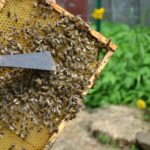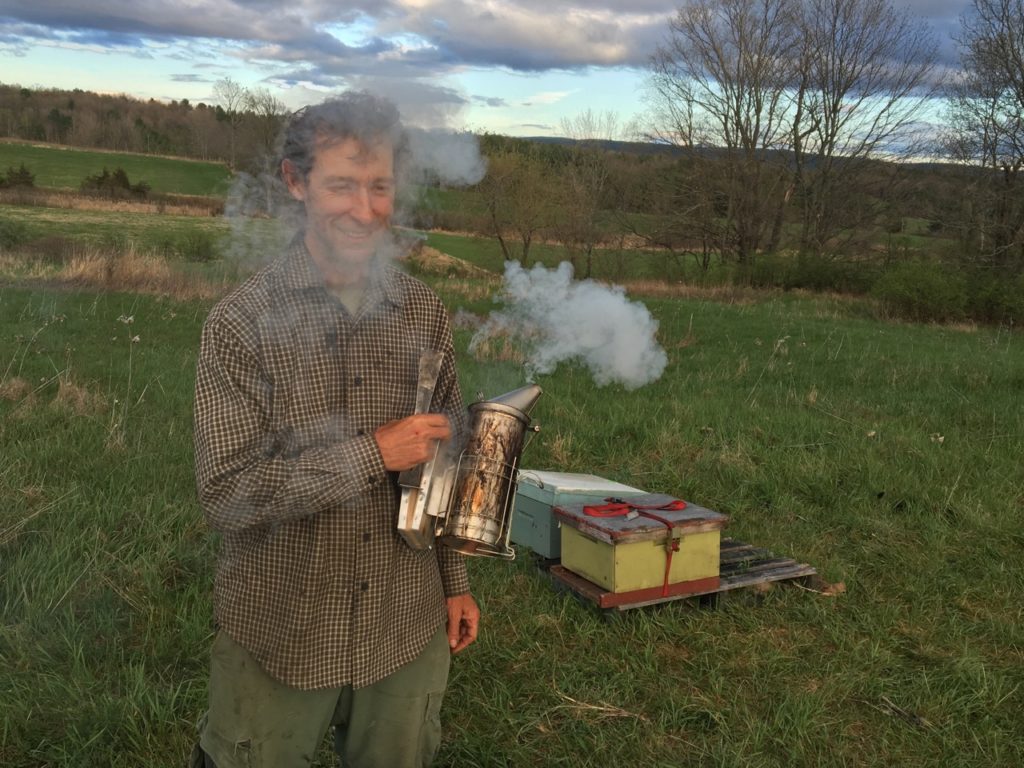Honey bees on the farm will pollinate our flowers. Todd began a relationship with honey bees over 50 years when he and his brother Tom, 9 years old, bought their first hive for their family farm. They were enchanted by how industrious the bees were, giving them honey, pollen, propolis and beeswax for candles and salve. Around 40% of what is eaten is pollinated by insects, this to a great degree by honey bees. Because there are so few nectar & pollen plants on Thornhill Farm, we are planting these plants for the bees. We know the soil is worn out on the farm because our honey bees make so little honey. This is why we have pigs. When the forest is cleared, we do not burn the wood that is left behind, but chip it and mix these wood chips with manure and fungus mycelium to make piles of compost to improve the soil. Last summer we grew peas and oats as a green manure crop, and the pea flowers gave voluminous amounts of nectar to the honey bees and pollinating insects.
Health & the Hive: A Beekeeper’s Journey
 A Jan Cannon Film that explores the importance of honeybees in our lives through the seasons of Honey Gardens Apiaries, Todd and the team. Topics addressed in the film include pollination, queen breeding, disease control, bee venom therapy, organic agriculture and honey-based plant medicine. 53 minute dvd. $10 + $4 (shipping).
A Jan Cannon Film that explores the importance of honeybees in our lives through the seasons of Honey Gardens Apiaries, Todd and the team. Topics addressed in the film include pollination, queen breeding, disease control, bee venom therapy, organic agriculture and honey-based plant medicine. 53 minute dvd. $10 + $4 (shipping).
to order, send a check to: 198 Taylor Road, Greensboro Bend, Vermont 05842
writings & images about the honey bees of Thornhill Farm
- Tim McFarline, McFarline Apiaries, Benson, Vermont June 3, 2016

Tim McFarline, McFarline Apiaries, Benson, Vermont. Tim raises queen bees organically from survivors and sells colonies of bees each Spring. We worked together for six years. May 2016.
Live from the Hive by Annie Watson – Winter 1997 to July 2015 archives
- Live from the Hive: April 2014“First Pollen” by Annie Watson, Thistle Hill Studio As soon as the weather warms up in April (we hope!) the bees will begin to collect pollen from the early-blooming plants. In Vermont, the first ones are pussy willow, goat willow, and red maple. Keep a lookout for that red “glow” on the hillsides in April. It’s ...
- Live from the Hive: March 2014“Feast Your Eyes” by Annie Watson As March begins, the cold continues unabated. Let’s feast our eyes on something other than more snow and ice. This photo shows a worker honey bee on a sumac flower. Sumac blooms in June and is a major food source for Vermont’s honey bees. This picture is a reminder of ...
- Live from the Hive: February 2014“Weather and Pollen Stores, an Intricate Dance” by Annie Watson Even as we face the coldest days of the winter, the queen begins laying eggs for the young that will replace those lost over the winter. If her family collected a lot of pollen in the fall and has abundant honey stored, she will start earlier, ...
- Live from the Hive: January 2014“Winter’s Depth” by Annie Watson In the deepest part of the winter, there’s no sign of life from the hives. But the bees inside are very much alive. Rather than hibernating, they are clustered together in a ball, surrounding and protecting the queen. It is remarkable that they can survive these cold temperatures. The hives, with their ...
- Live from the Hive: December 2013“Celebrating the Bees” By Annie Watson The first snow is on the ground. It was 16 degrees this morning here in the Champlain Valley. Inside the hive, the bees have massed into a ball to keep themselves warm. Now comes the time when we trust that they can withstand the cold weather of the year. We ...